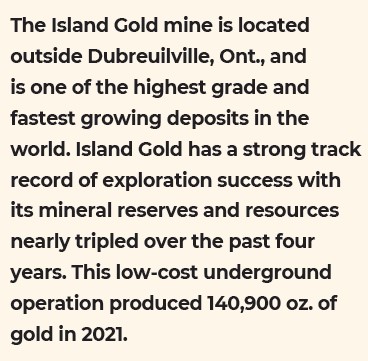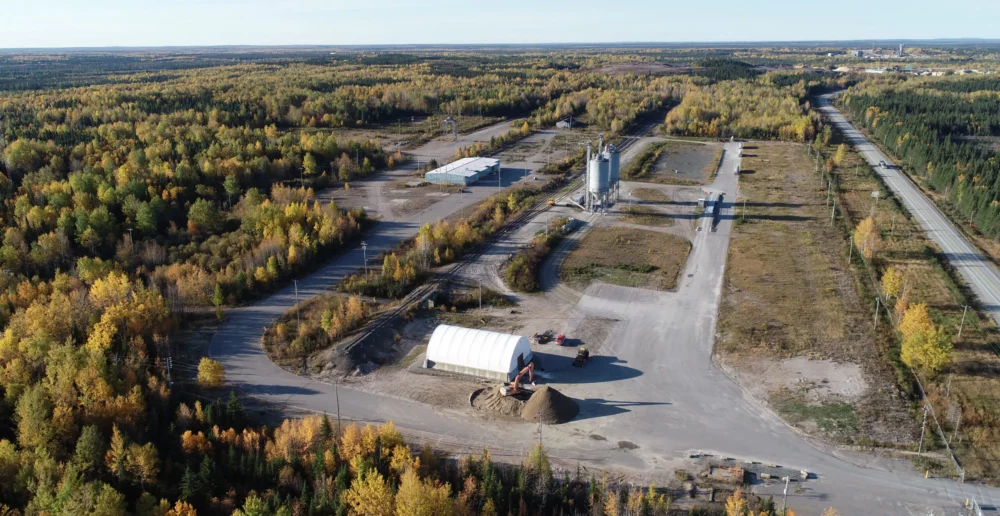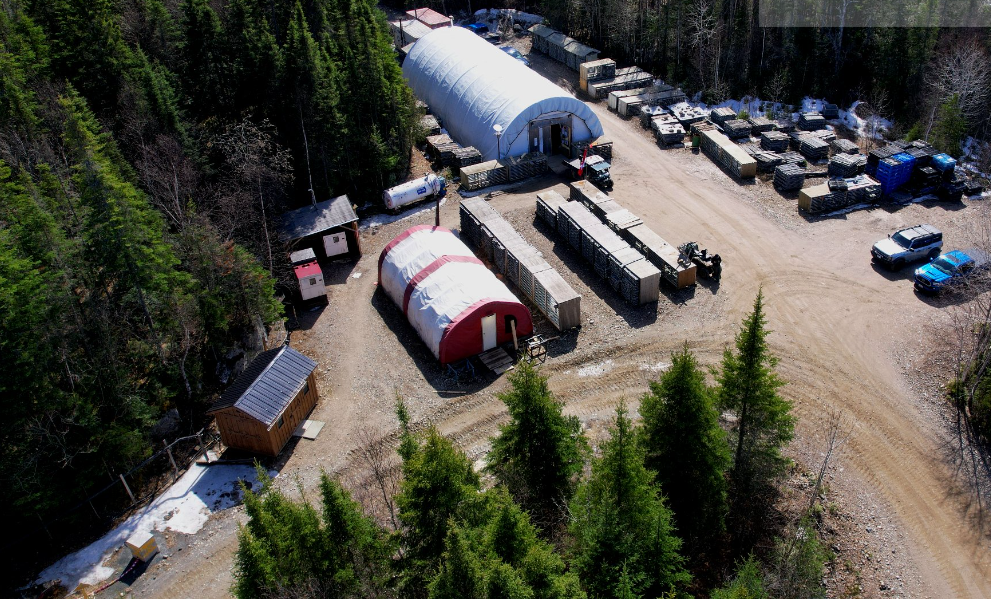Alamos Gold and the Island Gold mine success story

Alamos Gold is a Canadian-based gold producer that was formed in 2003. The company operates three mines: two in Canada (Island Gold mine and Young-Davidson mine) and one in Mexico (Mulatos mine) in addition to a strong portfolio of development stage projects in Canada, Mexico, Turkey, and the United States.

The Island Gold story
In November 2017, Alamos Gold acquired Richmont Mines and the Island Gold mine, a long-life, high-grade underground mine with growing production located in Ontario. Island Gold’s story began in 1985 when gold mineralization was first drilled. Richmont Mines achieved commercial production in October 2007 and Island Gold has since produced over 1.1 million oz. of gold.
Island Gold is one of Canada’s highest-grade and lowest-cost gold mines. Through ongoing exploration success, its mineral reserves and resources have continued to grow in both size and quality. This has supported a multiphase expansion of the operation, driving production higher, costs lower, and strong free cash flow growth.
The announcement
On June 28, 2022, Alamos Gold reported the results of the Phase 3+ expansion study which outlined a larger, more profitable, and valuable operation than outlined in the Phase 3 expansion study released in 2020. Based on the results of the Phase 3+ expansion study, Alamos announced that they are proceeding with an expansion of the operation to 2,400 t/d.
Phase 3+ expansion is more significant than Phase 3 for the following reasons:
> It will allow the expansion of the operations from 1,200 to 2,400 t/d, which is scheduled for completion in 2026 (as outlined in the timeline).
> It will drive production higher to an average of 287,000 oz. of gold per year at significantly lower costs.
> The mine life will be more than doubled, extending operations until 2039, which is four years more than what the Phase 3 expansion plans outlined.
> The expansion will transform Island Gold into one of Canada’s largest and most profitable gold mines. Following the completion of the expansion in 2026, the mine will be the seventh largest gold producer in Canada, the lowest cost, and the fifth most profitable.
How it was done: Expansion planning
To increase the plant throughput rate, the comminution circuit was assessed to identify its maximum capacity, and the existing crushing and grinding circuits were simulated at differing throughputs to determine which alternatives were available.
The assessment indicated that the existing crushers and mills can handle a maximum throughput of 1,600 t/d, which requires upgrades or additions to several of the other areas of the process plant such as the fine ore stockpile capacity, pre-leach thickening, leaching, CIP, acid wash, process water management, and other equipment.
The options to further increase the throughput of the plant to approximately 2,400 t/d included the following:
> The addition of an equivalent ball milling circuit in a parallel configuration, and
> The addition of a new SAG milling circuit prior to the existing mill to create an in-series grinding configuration.
The approach would also require a new crushing plant and additional upgrades to the leaching area, pre-leach thickener including its underflow pumps, tailings pumps, and process water management.
The comminution assessment also provided an option to increase the throughput of the process plant to 2,400 t/d by way of utilizing an SAB comminution circuit design. This would require installing a SAG milling circuit prior to the ball milling circuit (in-series grinding) as well as upgrades or additions to several other areas of the process plant.
Selected expansion approach
When selecting an option for the throughput expansion, Alamos Gold had to consider the following parameters:
1 The rate at which ore is delivered to the process plant from the mine,
2 Metallurgical performance (potential for gold loss mitigation),
3 Versatility (ability to cope with spikes in head grade, varying feed particle sizes, and mitigation of bottlenecks),
4 Construction complexity (duration of downtime and tie-in points to the existing plant),
5 Equipment reliability, and
6 Capital and operating costs for the plant changes.
The selected option was to combine the initial expansion plans from 1,200 t/d to 1,600 t/d with the parallel grinding expansion plan, to increase the production of the plant to 2,400 t/d, which entails the addition of a new ball milling circuit in parallel to the existing circuit as well as a new Pumpcell plant and elution circuit at the back end.
Utilizing a parallel milling circuit allows for a single milling stream to operate while the other stream is offline for maintenance. The downstream circuits may require modifications to allow the plant to run at the lower tonnage for an extended period.
The new shaft infrastructure
Following the completion of the expansion in 2026, the operation will transition from trucking ore and waste to skipping ore and waste to surface through the new shaft infrastructure, thus driving production higher and costs significantly lower.
The main components of the shaft infrastructure are unchanged from the 2000 Phase 3 study with the exception of the addition of a bin house and hoist drive cooling building. The bin house will allow for a more efficient and lower costs of transferring material to the haul trucks on surface.
A 5.0-m diameter concrete lined shaft will be constructed with a steel headframe. The shaft will house two 12-t skips in dedicated compartments for ore and waste movement and a double-deck service cage for the transport of personnel and materials. The shaft will be sunk to an initial depth of 1,373 m. The hoist is designed for an ultimate depth of 2,000 m, providing flexibility to accommodate future exploration success. At the initial depth of 1,373 m, the shaft has a capacity of 4,500 t/d, more than sufficient to accommodate the peak mining rates of 3,600 t/d (ore and waste).
Post completion of the shaft, a total of five haul trucks will be required to support a mining rate of 2,400 t/d. This compares to a peak of 18 haul trucks required to sustain ramp haulage at 1,200 t/d. This contributes to the lower ventilation requirements and significantly lower diesel usage.
A responsible miner
Alamos Gold adopts a sustainable business model through the following strategies:
1 Conservative, low-risk strategy: working in safe jurisdictions (100% North American production), being debt-free $122 million cash (as of June 30, 2022) and $622 million total liquidity, and fully funded organic growth.
2 A balanced approach to capital allocation.
3 A long-term track record of value creation: acquiring high-quality assets at weaker point in cycle; focus on exploration including discovering 3.7 million oz. of inferred mineral resources at Island Gold over the past four years at a cost of $12/oz.; $1.7 billion combined value added at Young-Davidson and Island Gold mines since acquisition.
Commitment to the local community
To support the economies of local communities, Island Gold offers training and education, including technical training to help local residents acquire the qualifications required for long-term employment at Island Gold and in the mining sector. Island Gold prioritizes hiring from Dubreuilville, Wawa, and White River, as well as contracting and sourcing unless their needs cannot be met locally.
The Phase 3+ expansion will create new job opportunities, and Alamos Gold attends and organizes job fairs, community meetings, and open houses. In 2021, 45% of the workforce was local.
Greenhouse gas emissions reduction
Phase 3+ expansion will result in a 35% reduction in life of mine greenhouse gas (GHG) emissions relative to the current operation, supporting the company-wide target of a 30% reduction in GHG emissions by 2030.
The shaft expansion option for Phase 3+ expansion – in addition to presenting the strongest economics and most efficient and productive scenario – also means that the operation will be less reliant on a mobile fleet of haul trucks using diesel. The shaft will be connected to clean, low-carbon intensity grid power, resulting in significantly lower diesel consumption.





Comments